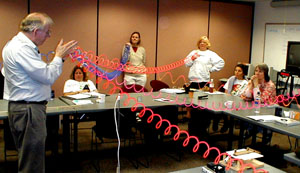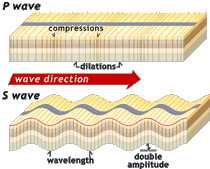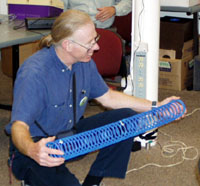Explorations with slinkies

John Lahr demonstrates seismic waves on slinkies.
Explorations with slinkies

John Lahr demonstrates seismic waves on slinkies.
Material
Slinkies, I prefer plastic slinkies.
To Do and Notice
Stretch a slinky between two people, perhaps 3 meters (10 ft) apart. The slinky will sag some.
Transverse Waves
Move one end of the slinky up and down quickly.
Notice how an upward wave pulse propagates along the slinky.
What is it that moves along the slinky?
Energy? Yes. The pulse moves the hand of the distant person slightly when it arrives. The hand experiences a force over a distance that it moves and so work is done on the hand by the pulse. Energy is the ability to do work. So energy does move.
The simplest description of what moves is motion. The upward motion of the slinks, i.e. one turn of a slinky, is passed along from one slink to its neighbor down the length of the slinky.
Notice there is a speed at which the pulse travels.
Notice that the pulse reflects off the hand of the distant person and returns as a downward pulse.
Notice that the pulse gets smaller in height as it travels. It loses energy as it travels.
Notice that if you move your hand upward and downward slowly, a longer pulse travels down the slinky. Notice that the longer pulse travels at the same speed as the shorter pulse.
Notice that if you move your hand upward further, a higher pulse moves down the slinky at about the same speed as the lower pulses.
Rule: The speed of a wave is often approximately the same for a wide range of amplitudes and pulse lengths or frequencies.
Move one end of the slinky to the right and then back to the center again quickly.
Notice that the pulse becomes a smaller leftward pulse after reflection.
Transverse waves can be up-down, or side-to-side, or at angles in-between the direction of the motion is called the polarization direction of the wave.
Move your hand in a circle, up-left-down-right, notice how the circular wave moves along the slinky. This is called a circularly polarized transverse wave. It is actually a left circularly polarized pulse.
You can also move your hand up-right-down-left to send a pulse which rotates in the opposite direction. This is called a right circularly polarized pulse.
If the up-down motion has a different amplitude than the right-left then the pulse becomes elliptically polarized.
So What?
Light
Light waves are transverse waves. In a vacuum all light frequencies and amplitudes travel at the same speed. In matter the speed of light does depend on its frequency.
Light can be linearly polarized, circularly polarized, or elliptically polarized.
Seismic waves
Earthquakes generate seismic waves that are transverse. These are called s-waves, they are the second waves to arrive at a seismograph.
S-waves travel through solids they do not travel through liquids or gasses.

Longitudinal waves.
Move your hand toward and away from your partner. (It will help to place the slinky on a smooth table top or to put a tightly stretched monofilament fishing line through the slinky, see Slinky in hand, or to hang every eighth slink from two threads, see Hanging Slinky.)

Notice how a pulse containing slinks that are closer together moves down the slinky. This is called a compression.
![]()
Move your hand away from your partner.
Notice how a pulse containing slinks that are wider apart moves down the slinky. This is called an expansion or a rarefaction.
If you move your hand forward and backward you make alternating compressions and expansions. This is called a longitudinal wave or a compression wave.
So What?
Sound waves are longitudinal waves.
Seismic waves can be longitudinal. These are called P-waves. They travel faster than S-waves and arrive first at distant seismic stations. P-waves can travel through solids liquids or gasses.
Going Further
Hold one end of each of 5 different slinkies and spread them out one straight ahead of you, one to either side and one 45 degrees to each side of the straight ahead one. See top photo.
If you move your hand straight away from you and then back again the wave that travels straight ahead will be a compression wave or P-wave, the waves that travel straight to the side will be S-waves and the waves that travel along the in-between slinkies will be both P-waves and S-waves.
Thus each earthquake will send out a pattern of P and S waves.
Surface Waves
Some waves exist only at the surface of a solid or liquid, think of ocean waves for example.
As you dive down underwater the motion of an ocean wave vanishes. The same thing happens with surface earthquake waves.
The motion of water in an ocean wave is in a vertical circle: up-forward-down-back, repeat. If you throw an orange into the ocean with non-breaking waves, you can watch it move in a circle as the waves flow past it. The wave travels from one place toward another, the water doesn't.
There are seismic waves that exist only at the surface, there are two types called Raleigh waves and Love waves. These surface seismic waves travel slower than both P-waves and the S-waves.

Torsion waves
Put a few masking tape flags along the top of a slinky. Without moving it up-down, right-left or forward and back twist it clockwise. Notice how the flags show a wave of twist or torsion moving down the slinky.
So What?
The string of a violin moves side to side and also twists when it is bowed.
|
Scientific Explorations with Paul Doherty |
|
1 Sep 2002 |